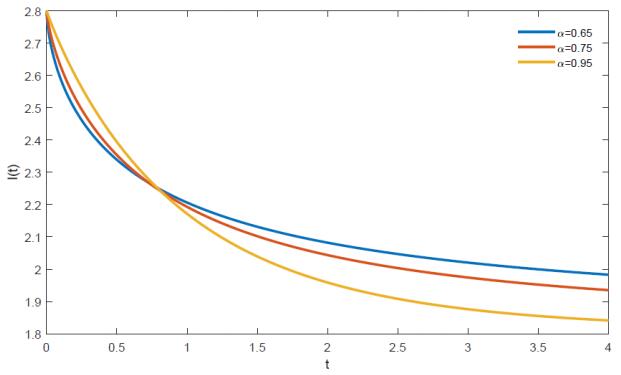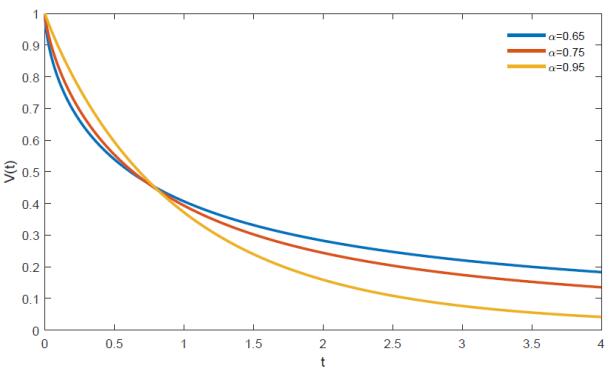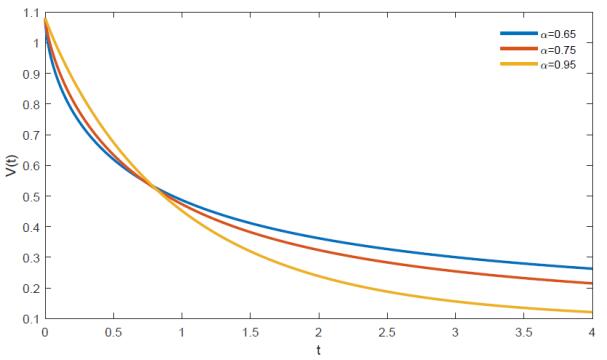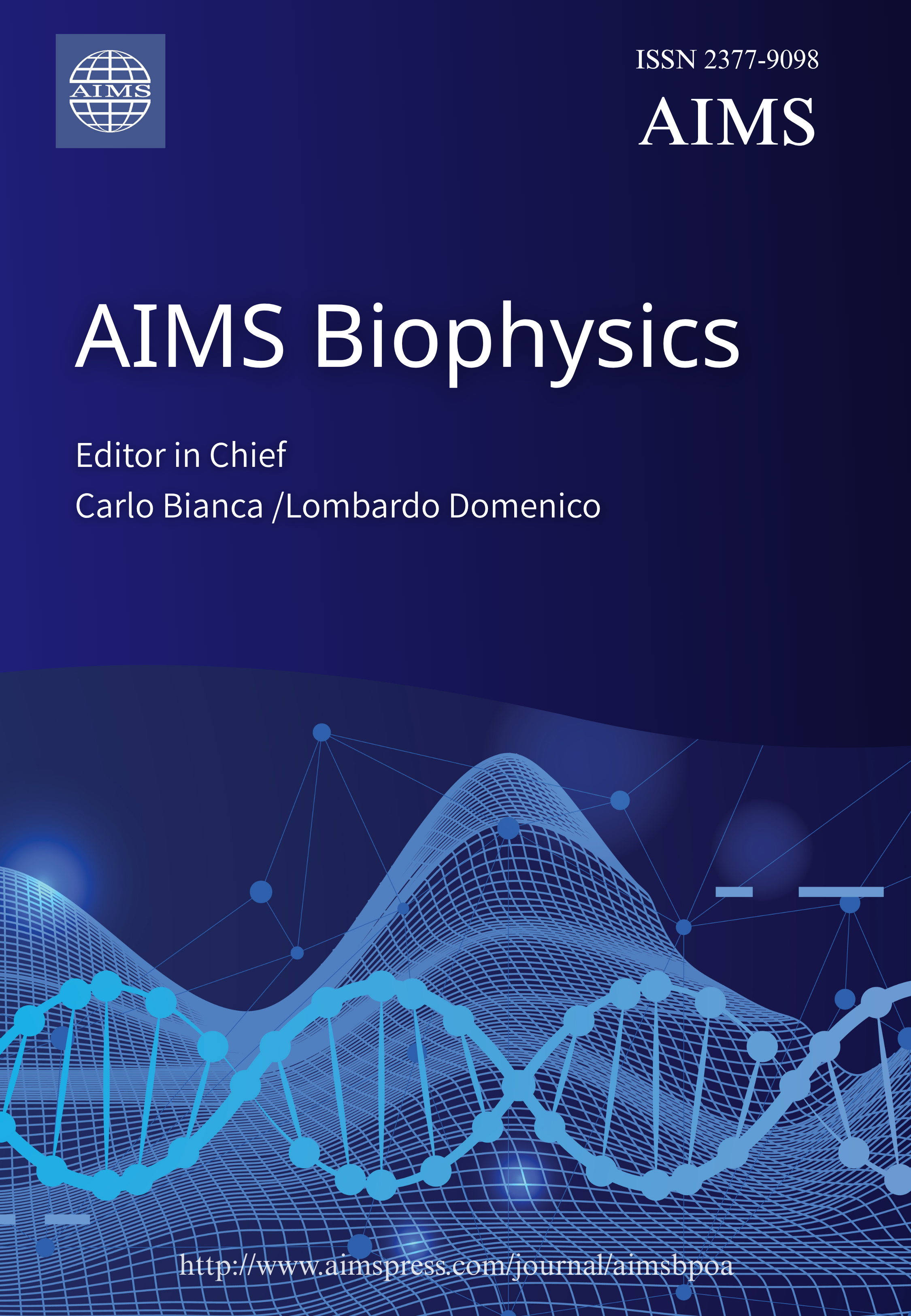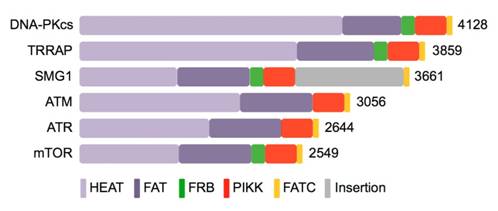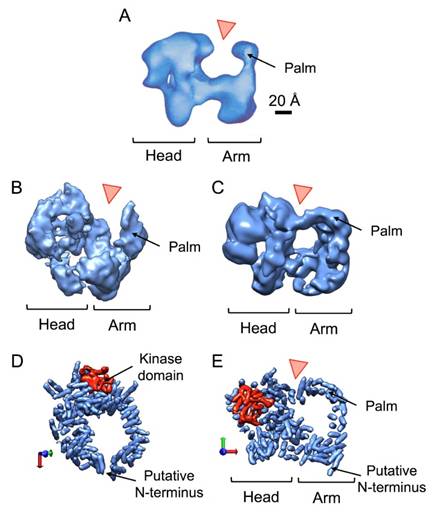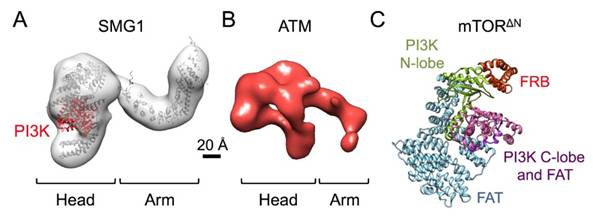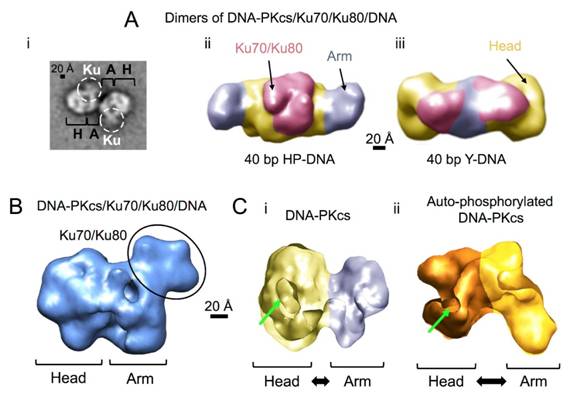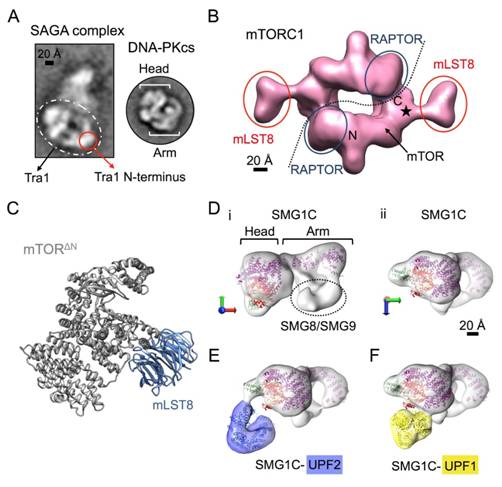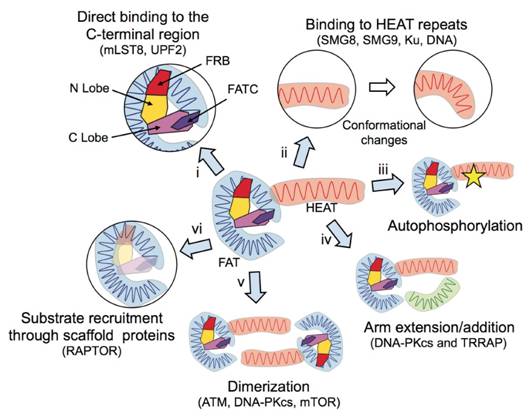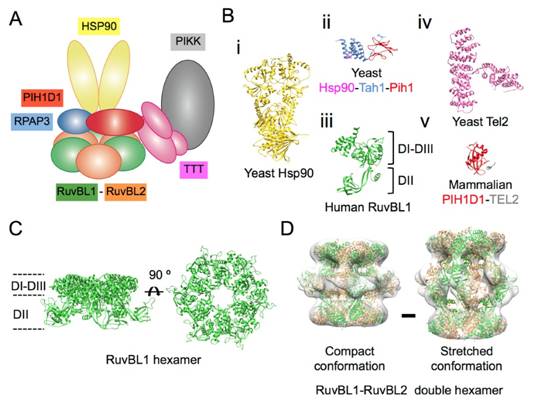The phosphatidylinositol 3-kinase-like kinases (PIKKs) are large serine-threonine protein kinases with a catalytic domain homologous to the phosphatidylinositol 3-kinase (PI3K). All PIKK family members share a general organization comprising a conserved C-terminus that contains the PI3K domain, which is preceded by a large N-terminal region made of helical HEAT repeats. In humans, the PIKK family includes six members, which play essential roles in various processes including DNA repair and DNA damage signalling (ATM, ATR, DNA-PKcs), control of cell growth (mTOR), nonsense-mediated mRNA decay (SMG1) and transcriptional regulation (TRRAP). High-resolution structural information is limited due to the large size (approx. 280-470 kDa) and structural complexity of these kinases. Adding further complexity, PIKKs work as part of larger assemblies with accessory subunits. These complexes are dynamic in composition and protein-protein and protein-DNA interactions regulate the kinase activity and functions of PIKKs. Moreover, recent findings have shown that the maturation and correct assembly of the PIKKs require a large chaperon machinery, containing RuvBL1 and RuvBL2 ATPases and the HSP90 chaperon. Single-particle electron microscopy (EM) is making key contributions to our understanding of the architecture of PIKKs and their complex regulation. This review summarizes the findings on the structure of these kinases, focusing mainly on medium-low resolution structures of several PIKKs obtained using EM, combined with X-ray crystallography of DNA-PKcs and mTOR. In addition, EM studies on higher-order complexes have revealed some of the mechanisms regulating the PIKKs, which will also be addressed. The model that emerges is that PIKKs, through their extensive interacting surfaces, integrate the information provided by multiple accessory subunits and nucleic acids to regulate their kinase activity in response to diverse stimuli.
1.
Introduction
Recently, the electrical circuit equations as Resistor-Capacitor (RC) and Resistor-Inductor (RL) have attracted many mathematicians [3,15]. The analytical solutions of the electrical circuit equations described by a singular and a no-singular fractional derivative operators have been proposed. In [6], Aguilar et al. have introduced the electrical circuit equations considering the Caputo fractional derivative. They have proposed the analytical solutions of the electrical RC and RL equations described by the Caputo fractional derivative. In [6], the authors have proposed the graphical representations to illustrate the main results. The Caputo fractional derivative is a fractional derivative with a regular kernel. Recently, the fractional derivative operators with no-singular kernels were introduced in the literature. The Caputo-Fabrizio fractional derivative and the Atangana-Baleanu fractional derivative. In [5], Aguilar et al. have introduced electrical equations considering the fractional derivative operators with two parameters. They have proposed the solutions of the electrical RL and RC circuit equations described by the fractional derivative operators with two parameters $\alpha, \beta\in(0, 1]$. In [5], the authors have introduced electrical circuit equations using the Atangana-Baleanu fractional derivative. They have proposed the analytical solutions using the Laplace transform. They have presented the numerical scheme of the Atangana-Baleanu fractional derivative of getting the analytical solutions of the electrical RC and RL circuit equations. In [4], Aguilar et al. have presented the electrical circuit equations using the Caputo-Fabrizio fractional derivative. They have proposed the graphical representations of the analytical solutions. In [8], Aguilar et al. have investigated of getting the analytical solution of the RLC circuit equation described by the Caputo fractional derivative. In [7], Aguilar et al. have analyzed and proved the jerk dynamics can be obtained with the electrical circuit equations. There exist many other works related to the analytical solutions, seen in [11,20]. The stability problem interests many mathematicians. The stability problem studies the behaviors of the analytical solutions of the fractional differential equations. The analytical solution of the electrical circuit described by the singular and the no-singular fractional derivative operators is an open problem in fractional calculus and continues to receive many investigations. The analytical solutions of the electrical circuits exist. We can get them. The problem is how to analyze the behaviors of these solutions using stability notions. In [14], the authors have analyzed the stability of the electrical RLC circuit equation. The electrical RL and RC circuit equations contain source terms. The source terms have some properties. The source term of the electrical circuit equations can be constant [10]. The source term can be sinusoidal [5]. They exist some source terms which converge in the times [10]. In stability problems, there exists a novel notion of studying the behaviors the fractional differential equations with these characteristics. This notion is called the fractional input stability recently introduced in the literature by Sene in [18,19]. In this paper, the function containing the source term will be considered as the exogenous input. The contribution of our paper is to recall the analytical solutions of the electrical RL and RC circuit equations described by the Riemann-Liouville and the Caputo fractional derivative using the Laplace transform. Secondly, we will analyze the behaviors of the obtained analytical solutions of the electrical RL and RC circuit equations using the fractional input stability. In other words, we investigate the fractional input stability of the electrical RL and RC circuit equations described by the Riemann-Liouville and the Caputo fractional derivative. The fractional input stability resumes three properties. Firstly, when the considered exogenous input converges, then the analytical solution of the considered electrical circuit converges as well. In other words, a converging input generates a converging state. That is the CICS property of the fractional input stability. Secondly, when the exogenous input is bounded, then the analytical solution of the considered electrical circuit is bounded as well. In other words, a bounded input generates a bounded state. That is the BIBS property of the fractional input stability. And at last, when the the exogenous input is null, then the trivial solution of the unforced electrical circuit is globally asymptotically stable. A fractional differential equation is said to be fractional input stable when the norm of the analytical solution at all times is bounded by a function proportional to the initial state and converging to zero in times plus a positive function depending to the norm of the exogenous input.
In stability problems in fractional calculus, the asymptotic stability is provided in many manuscripts. Using the fractional input stability, we can study the uniform global asymptotic stability of the fractional differential equations. Presently, the stability conditions for the asymptotic stability were provided in the literature. This paper offers an alternative to study the (uniform) global asymptotic stability of the fractional differential equations. It is the main contribution of this paper. The application of the fractional input stability of the fractional differential equations is the second contribution of this paper.
The paper is described as the following form. In Section 2, we recall preliminary definitions of the fractional derivative operator and recall the definitions of the stability notions. In Section 3, we investigate the analytical solutions of the electrical RL, RC and LC circuit equations described by the Riemann-Liouville fractional derivative and the Caputo fractional derivative. We analyze the fractional input stability of the obtained analytical solutions. In Section 4, we give the graphical representations of the fractional input stability of the electrical RC and RL circuit equations described by the Caputo fractional derivative operator. In Section 5, we give the conclusions and the remarks.
Notation: $\mathcal{PD}$ denotes the set of all continuous functions $\chi:\mathbb R_{\geq 0}\to\mathbb R_{\geq 0}$ satisfying $\chi(0) = 0$ and $\chi(s)>0$ for all $s>0$. A class $\mathcal{K}$ function is an increasing $\mathcal{PD}$ function. The class $\mathcal{K}_{\infty}$ denotes the set of all unbounded $\mathcal{K}$ function. A continuous function $\beta : \mathbb{R}_{\geq 0}\times \mathbb{R}_{\geq 0}\rightarrow \mathbb{R}_{\geq 0}$ is said to be class $\mathcal{KL}$ if $\beta(., t)\in \mathcal{K}$ for any $t\geq0$ and $\beta(s, .)$ is non increasing and tends to zero as its arguments tends to infinity. Let $x\in\mathbb R^n$, $\left\|x\right\|$ stands for its Euclidean norm: $\left\|x\right\|: = \sqrt{x_1^2+\ldots+x_n^2}$.
2.
Preliminary definitions
In this section, we recall the definitions of the fractional derivative operators and the definition of the fractional input stability introduced in the literature [18,19] of fractional calculus. We recall the definition of the Caputo fractional derivative.
Definition 1. [9,16,17] Consider a function $f:[0, +\infty[\longrightarrow\mathbb{R}$, the Caputo fractional derivative of the function $f$ of order $\alpha$ is formulated as the following form
for all $t>0, $ we consider $\alpha\in\left(0, 1\right)$ and $\Gamma(.)$ is the gamma function.
The Riemann-Liouville fractional derivative is recalled in the following definition.
Definition 2. [9,13] Consider a function $f:[0, +\infty[\longrightarrow\mathbb{R}$, the Riemann-Liouville fractional derivative of the function $f$ of order $\alpha$ is formulated as the following form
for all $t>0, $ we consider $\alpha\in\left(0, 1\right)$ and $\Gamma(.)$ is the gamma function.
The Riemann-Liouville fractional integral is recalled in the following definition.
Definition 3. [12,18,19] Consider a function $f:[0, +\infty[\longrightarrow\mathbb{R}$, the Riemann-Liouville fractional integral of the function $f$ of order $\alpha$ is represented as the following form
for all $t>0, $ we consider $\alpha\in\left(0, 1\right)$ and $\Gamma(.)$ is the gamma function.
Definition 4. [1,2] The Mittag–Leffler function with two parameters is expressed as the following form
where $\alpha>0, $$\beta\in\mathbb{R}$ and $z\in \mathbb{C}$.
We consecrate this section of recalling some stability notions introduced in [18,19]. In general, the fractional differential equation under consideration is defined by
where $x\in \mathbb{R}^{n}$, a continuous and locally Lipschitz function $f:\mathbb{R}^{+}\times \mathbb{R}^{n}\times \mathbb{R}^{m}\longrightarrow\mathbb{R}^{n}$ and $u\in \mathbb{R}^{m}$ represents the exogenous input. Note that the solution of the fractional differential equation (2.5) exists under the assumption "the function $f$ is continuous and locally Lipschitz". The existence of the solution is fundamental in the stability problems. It is not necessary to study the stability of the fractional differential equation when we are not sure its the solution exists.
Definition 5. [18,19] The fractional differential equation (2.5) is fractional input stable if for any exogenous input $u\in\mathbb{R}^{m}$, there exists a function $\beta \in \mathcal{KL}$, a function $\gamma \in \mathcal{K}_{\infty}$ such that for any initial state $x_{0}$ the solution of (2.5) satisfies
The function $\gamma$ is a class $\mathcal{K}_{\infty}$ function and the function $\beta$ is a class $\mathcal{KL}$. Thus, from equation (2.6), when the exogenous input $u$ of the fractional differential equation (2.5) is bounded it follows its solution is bounded as well, that is the BIBS property. See the proof in the next section or in the original paper [18]. We can also notice, when the exogenous input of the fractional differential equation (2.5) converges, when $t$ tends to infinity, then its solution converges as well, that is CICS property, see in [18] for more details. At last, we observe from equation (2.6) when the exogenous input into the fractional differential equation (2.5) is null; we recover the definition of the global asymptotic stability described in the following definition.
Definition 6. [16] The trivial solution of the unforced fractional differential equation defined by $D^{c}_{\alpha}x = f(t, x, 0)$ is said to be (uniform) globally asymptotically stable if there exist a function $\beta \in \mathcal{KL}$, such that for any initial condition $x_{0}$ the solution of $D^{c}_{\alpha}x = f(t, x, 0)$ satisfies
The last remark is the main contribution of the fractional input stability of the fractional differential equations. We finish this section by recalling the following lemma. It will be used to introduce comparison functions.
Lemma 1. [21] Let $\alpha\in(0, 2)$, $\beta$ is a real number, a matrix $A\in \mathbb{C}^{n\times n}$, $\mu$ is such that $\frac{\pi\alpha}{2}<\mu< \min\left\{\pi, \pi\alpha\right\}$ and $C>0$ is a real, then it holds that
where $\mu\leq \arg\left(\lambda(A)\right)\leq\pi$, $\lambda(A)$ represents the eigenvalues of the matrix $A.$
3.
Fractional input stability of the electrical circuits equations described by certain fractional derivative operators
In this section, we address the fractional input stability of the electrical circuit equations described by the Riemann-Liouville and the Caputo fractional derivative operators. The electrical circuit equations under consideration are the electrical RL circuit equation, the electrical LC circuit equation, and the electrical RC circuit equation. We analyze the bounded input bounded state (BIBS), the converging input converging state (CICS) and the (uniform) global asymptotic stability of the unforced fractional electrical circuit equations, properties derived to the fractional input stability of the electrical circuit equations. It is important to note, in the rest of the paper, the second term of all the fractional electrical circuit equations is considered as a single function which represents the exogenous input.
3.1. Fractional input stability of the electrical RL circuit equation described by the Riemann-Liouville fractional derivative
In this section, we address the fractional input stability of the electrical RL circuit described by the Riemann-Liouville fractional derivative. We consider the electrical RL circuit represented by the following fractional differential equation
with the initial boundary condition defined by $\left(I^{1-\alpha}I\right)(a) = I_{0}$. $I$ represents the current across the inductor. The parameter $\sigma$ is associated with the temporal components in the system, see more details in [5,6]. $R$ represents the resistance, and $L$ represents the inductance. In the second member, $u(t)$ is considered as the exogenous input. It contains the source term $E(t)$ (eventually depend on time), the function $1/L$ and the temporal coefficient $\sigma^{1-\alpha}$. Summarizing $u(t) = \frac{\sigma^{1-\alpha}E(t)}{L}$.
Theorem 1. The electrical RL circuit defined by equation (3.1) described by the Riemann-Liouville fractional derivative is fractional input stable.
Proof: We first determine the analytical solution of the fractional differential equation defined by equation (3.1). Applying the Laplace transform to both sides of equation (3.1), we obtain the following relationships
where $\mathcal{L}$ represents the usual Laplace transform and "$\ast$" represents the usual convolution product. Applying the inverse of Laplace transform to both sides of equation (3.2), we obtain the following analytical solution
From which it follows by applying the euclidean norm
We know the term $-\frac{\sigma^{1-\alpha}R}{L}\leq 0$, then there exists a positive constant $M$ such that we have the following inequality [17]
Using Lemma 1 and inequality (3.5), we obtain the following inequality
Let the function $\beta\left(I_{0}, t\right) = \frac{I_{0}C_{1}}{\left\|t^{1-\alpha}\right\|+\frac{\sigma^{1-\alpha}R}{L}\left\|t\right\|}$. We observe the function $\beta\left(., t\right)$ is a class $\mathcal{K}$ function. Furthermore, $\beta\left(s, .\right)$ decays with the time and converges to zero when $t$ tends to infinity, thus $\beta\left(s, .\right)$ is a class $\mathcal{L}$ function. In conclusion the function $\beta$ is a class $\mathcal{KL}$ function. Let the function $\gamma\left(\left\|u\right\|\right) = \left\|u\right\|M$, it is straightforward to see $\gamma$ is a class $\mathcal{K}_{ \infty}$ function. Finally, equation (3.6) is represented as follows
It follows from equation (3.7) the electrical RL circuit described by the Riemann-Liouville fractional derivative is fractional input stable.
Let the exogenous input $\left\|u\right\| = 0$ then $\gamma\left(0\right) = 0$ (because $\gamma$ is a class $\mathcal{K}_{ \infty}$ function), thus equation (3.7) becomes
Then the equilibrium point $I = 0$ of the electrical RL circuit defined by
is (uniformly) globally asymptotically stable. Then, the fractional input stability of the electrical RL circuit equation (3.1) implies the global asymptotic stability of the unforced electrical RL circuit equation (3.9). Proving the global asymptotic stability of the equilibrium point $I = 0$ of the unforced electrical RL circuit equation (3.9) using the fractional input stability is essential. The classical tools give the asymptotic stability of the equilibrium point $I = 0$. Its don't give the global asymptotic stability. Thus, the fractional input stability is a good compromise in the stability problems. We observe when the exogenous input of equation (3.1) converges; then from equation (3.7), we notice the analytical solution of the electrical RL circuit equation (3.1) converges as well. That is the CICS property. Furthermore, from equation when the exogenous input equation (3.1) is bounded, then the analytical solution of the electrical RL circuit equation (3.1) is bounded as well. We give the proof. Let the exogenous input $\left\|u\right\|\leq\eta$ then from the fact $\gamma$ is a class $\mathcal{K}_{ \infty}$, there exists $\epsilon$ such that $\gamma\left(\left\|u\right\|\right)\leq\epsilon$. Then equation (3.7) becomes
Thus the analytical solution is bounded as well.
3.2. Fractional input stability of the electrical RL circuit described by the Caputo fractional derivative
In this section, we replace the Riemann-Liouville fractional derivative by the Caputo fractional derivative. We address the fractional input stability of the electrical RL circuit described by the Caputo fractional derivative. The following fractional differential equation defines the electrical RL circuit equation described by the Caputo fractional derivative
with the initial boundary condition defined by $I(0) = I_{0}$. The term $u(t)$ represents the exogenous input as defined in the previous section.
Theorem 2. The electrical RL circuit defined by equation (3.11) described by the Caputo fractional derivative is fractional input stable.
Proof: We apply the Laplace transform to both sides of equation (3.11), we obtain the following relationships
where $\mathcal{L}$ represents the usual Laplace transform and "$\ast$" represents the usual convolution product. We apply the inverse of Laplace transform to both sides of equation ((3.12). We obtain the following analytical solution
We apply the usual euclidean norm to equation ((3.13). It follows the following inequality
The characteristic term $-\frac{\sigma^{1-\alpha}R}{L}\leq 0$, then there exists a positive constant $M$ such that the following inequality is held
Using Lemma 1 and the inequality defined by equation (3.15), we obtain the following inequality
Let the function $\beta\left(I_{0}, t\right) = \frac{I_{0}C_{1}}{1+\frac{\sigma^{1-\alpha}R}{L}\left\|t^{\alpha}\right\|}$. We observe the function $\beta\left(., t\right)$ is a class $\mathcal{K}$ function. Furthermore, $\beta\left(s, .\right)$ decays in time and converges to zero when $t$ tends to infinity, thus the function $\beta\left(s, .\right)$ is a class $\mathcal{L}$ function. In conclusion the function $\beta$ is a class $\mathcal{KL}$ function. Let the function $\gamma\left(\left\|u\right\|\right) = \left\|u\right\|M$. The function $\gamma$ is a class $\mathcal{K}_{ \infty}$ function. Finally, equation (3.16) is represented as the following form
It follows from equation (3.17) the electrical RL circuit equation described by the Caputo fractional derivative is fractional input stable.
Let the exogenous input $u = 0$. From the fact $\gamma$ is a class $\mathcal{K}_{ \infty}$ function, we have $\gamma\left(0\right) = 0$. Equation (3.17) is represented as the following form
From equation (3.18), the equilibrium point $I = 0$ of the electrical RL circuit equation described by the Caputo fractional derivative defined by
is globally asymptotically stable. Then, the fractional input stability of equation (3.11) implies the global asymptotic stability of the unforced electrical RL circuit equation (3.19). We observe when the exogenous input of equation (3.11) converges, then from equation (3.17), we notice the analytical solution of the electrical RL circuit equation (3.11) converges as well. From equation (3.17), the analytical solution of the electrical RL circuit equation (3.11) described by the Caputo fractional derivative is bounded as well when the exogenous input is bounded.
3.3. Fractional input stability of the electrical LC circuit described by the Riemann-Liouville fractional derivative
In this section, we study the fractional input stability of the electrical LC circuit described by the Riemann-Liouville fractional derivative. The electrical LC circuit equation under consideration is defined by the following fractional differential equation
with the initial boundary condition defined by $\left(I^{1-2\alpha}I\right)(0) = I_{0}$ and $\alpha\leq1/2$ (in this paper). $I$ represents the current across the inductor. The parameter $\sigma$ is associated with the temporal components in the system, see more details in [6]. In the second member, $u(t)$ represents the exogenous input. It is expressed using the source term $E(t)$ (eventually depend on time), the function $C/\sqrt{LC}$ and the temporal coefficient $\sigma^{1-\alpha}$. Summarizing, we have $u(t) = \frac{\sigma^{1-\alpha}CE(t)}{\sqrt{LC}}$. We make the following theorem.
Theorem 3. The electrical LC circuit equation defined by equation (3.20) described by the Riemann-Liouville fractional derivative is fractional input stable.
Proof: Let $\beta = 2\alpha$. We apply the Laplace transform to both sides of equation (3.20), we obtain the following relationships
where $\mathcal{L}$ represents the usual Laplace transform and "$\ast$" represents the usual convolution product. We apply the inverse of Laplace transform to both sides of equation (3.21). We obtain the following analytical solution
We apply the euclidean norm to both sides of equation (3.22). We get the following relationship
From the assumption $-\frac{\sigma^{1-\alpha}}{\sqrt{LC}}\leq 0$, there exists a positive constant $M$ such that we have the following inequality.
We use Lemma 1 and inequality (3.23), we obtain the following inequality
Let the function $\mu\left(I_{0}, t\right) = \frac{I_{0}C_{1}}{\left\|t^{1-\beta}\right\|+\frac{\sigma^{1-\alpha}}{\sqrt{LC}}\left\|t\right\|}$. We observe the function $\mu$ is a class $\mathcal{KL}$ function. Let the function $\gamma\left(\left\|u\right\|\right) = \left\|u\right\|M$, it is straightforward to verify the function $\gamma$ is a class $\mathcal{K}_{ \infty}$ function. Finally, equation (3.25) is represented as follows
It follows from equation (3.26) the electrical LC circuit described by the Riemann-Liouville fractional derivative is fractional input stable.
Let the exogenous input $\left\|u\right\| = 0$. From the fact $\gamma\left(0\right) = 0$, equation (3.26) becomes
Thus the equilibrium point $I = 0$ of the electrical LC circuit defined by
is globally asymptotically stable. As in the previous sections, the fractional input stability of equation (3.20) implies the global asymptotic stability of the unforced electrical LC circuit equation (3.28). We observe when the exogenous input of equation (3.20) converges, it follows from equation (3.26), the analytical solution of the electrical LC circuit equation (3.20) converges as well. It follows from equation (3.26), the analytical solution of the electrical LC circuit equation (3.20) is bounded as well when its exogenous input of equation is bounded.
3.4. Fractional input stability of the electrical LC circuit described by the Caputo fractional derivative
We consider the Caputo fractional derivative in this section. We investigate the fractional input stability of the electrical LC circuit equation defined by the following fractional differential equation
with the initial boundary condition defined by $I(0) = I_{0}$ and $\alpha\leq1/2$. The exogenous input is $u(t)$.
Theorem 4. The electrical LC circuit equation defined by equation (3.29) described by the Caputo fractional derivative is fractional input stable.
Proof: Let $\beta = 2\alpha$. We determine the analytical solution of the fractional differential equation defined by (3.29). We apply the Laplace transform to both sides of equation (3.29). We obtain the following relationships
where $\mathcal{L}$ represents the usual Laplace transformation and "$\ast$" represents the usual convolution product. We apply the inverse of Laplace transform to both sides of equation (3.30). We obtain the following analytical solution
We apply the euclidean norm to both sides of equation (3.31). We obtain the following inequality
From the assumption $-\frac{\sigma^{1-\alpha}}{\sqrt{LC}}\leq 0$, there exists a positive constant $M$ such that the following inequality is held
We use Lemma 1 and equation (3.33), we obtain the following inequality
Let the function $\mu\left(I_{0}, t\right) = \frac{I_{0}C_{1}}{1+\frac{\sigma^{1-\alpha}}{\sqrt{LC}}\left\|t^{\beta}\right\|}$. We observe the function $\mu\left(., t\right)$ is a class $\mathcal{K}$ function. Furthermore, $\mu\left(s, .\right)$ decays in time and converges to zero when $t$ tends to infinity. Thus $\mu\left(s, .\right)$ is a class $\mathcal{L}$ function. In conclusion the function $\mu$ is a class $\mathcal{KL}$ function. Let the function $\gamma\left(\left\|u\right\|\right) = \left\|u\right\|M$, it is straightforward to see $\gamma$ is a class $\mathcal{K}_{ \infty}$ function. Finally equation (3.34) is represented as follows
It follows from equation (3.35) the electrical LC circuit equation (3.29) described by the Caputo fractional derivative is fractional input stable.
Let's analyze the BIBS, the CICS properties and the global asymptotic stability of the unforced electrical LC circuit equation. Let the exogenous input $\left\|u\right\| = 0$. From the fact $\gamma$ is a class $\mathcal{K}_{ \infty}$ function, we have $\gamma\left(0\right) = 0$. Then the equation (3.35) becomes
That is the trivial solution of the electrical LC circuit equation described by the Caputo fractional derivative defined by
is globally asymptotically stable. That is to say the fractional input stability implies the global asymptotic stability of the unforced electrical RL circuit described by the Caputo fractional derivative. From equation (3.35), when the exogenous input of equation (3.29) converges then the analytical solution of the electrical LC circuit equation (3.29) converges as well. We notice from equation (3.35), when the exogenous input of equation (3.29) is bounded, then the analytical solution of the electrical LC circuit equation (3.29) described by the Caputo fractional derivative is bounded as well.
3.5. Fractional input stability of the electrical RC circuit equation described by the Riemann-Liouville fractional derivative
In this section, we investigate the fractional input stability of the electrical RC circuit equation described by the Riemann-Liouville fractional derivative. Let the electrical RC circuit equation defined by the following fractional differential equation
with the initial boundary condition defined by $\left(I^{1-\alpha}V\right)(0) = V_{0}$. $C$ represents the capacitance and $R$ represents the resistance. $V$ represents the voltage across the capacitor. The parameter $\sigma$ is associated to the temporal components in the system, see more details in [5]. The second member, $u(t)$ is considered as the exogenous input. It contains the source term $E(t)$ (eventually depend on time), the function $1/RC$ and the temporal coefficient $\sigma^{1-\alpha}$. Summarizing $u(t) = \frac{\sigma^{1-\alpha}E(t)}{RC}$. We make the following theorem.
Theorem 5. The electrical RC circuit defined by equation (3.38) described by the Riemann-Liouville fractional derivative is fractional input stable.
Proof: Applying the Laplace transform to both sides of equation (3.38), we get the following relationships
where $\mathcal{L}$ represents the usual Laplace transform and "$\ast$" represents the usual convolution product. Applying the inverse of Laplace transform to both sides of equation (3.39), we obtain the following analytical solution
Applying the euclidean norm on equation (3.40), we have
From the assumption $-\frac{\sigma^{1-\alpha}}{RC}\leq 0$, there exists a positive constant $M$ such that we have the following inequality
We use Lemma 1 and the inequality (3.42), we obtain the following inequality
Let the function $\beta\left(V_{0}, t\right) = \frac{V_{0}C_{1}}{\left\|t^{1-\alpha}\right\|+\frac{\sigma^{1-\alpha}}{RC}\left\|t\right\|}$. We observe the function $\beta$ is a class $\mathcal{KL}$ function. Let the function $\gamma\left(\left\|u\right\|\right) = \left\|u\right\|M$. It is straightforward to see $\gamma$ is a class $\mathcal{K}_{ \infty}$ function. Finally, equation (3.43) is represented as the following form
It follows from equation (3.44) the electrical RC circuit equation described by the Riemann-Liouville fractional derivative is fractional input stable.
Let the exogenous input $\left\|u\right\| = 0$, then we have $\gamma\left(0\right) = 0$. Thus the equation (3.44) becomes
Then the equilibrium point $V = 0$ of the electrical RC circuit equation defined by
is (uniformly) globally asymptotically stable. Thus the fractional input stability implies the global asymptotic stability of the unforced electrical RC circuit described by the Riemann-Liouville fractional derivative. We observe from (3.44) when the exogenous input of equation (3.38) converges, we notice the analytical solution of the electrical RC circuit equation (3.38) converges as well. From (3.44), when the exogenous input term of equation (3.38) is bounded, then the analytical solution of the electrical RC circuit equation (3.38) is bounded as well.
3.6. Fractional input stability of the electrical RC circuit equation described by the Caputo fractional derivative
In this section, we investigate the fractional input stability of the electrical RC circuit equation described by the Caputo fractional derivative defined by the following fractional differential equation
with the initial boundary condition defined by $V(0) = V_{0}$. The term $u(t)$ represents the exogenous input as defined in the previous section.
Theorem 6. The electrical RC circuit defined by equation (3.47) described by the Caputo fractional derivative is fractional input stable.
Proof: Applying the Laplace transform to both sides of equation (3.47), we obtain the following relationships
where $\mathcal{L}$ represents the usual Laplace transform and "$\ast$" represents the usual convolution product. Applying the inverse of Laplace transform to both sides of equation (3.48), we obtain the following analytical solution
From which we have the following inequality
From the assumption $-\frac{\sigma^{1-\alpha}}{RC}\leq 0$, there exists a positive constant $M$ such that the following inequality is held
We use Lemma 1 and equation (3.51), we obtain the following relationships
Let the function $\beta\left(V_{0}, t\right) = \frac{V_{0}C_{1}}{1+\frac{\sigma^{1-\alpha}}{RC}\left\|t^{\alpha}\right\|}$. We observe the function $\beta$ is a class $\mathcal{KL}$ function. Let the function $\gamma\left(\left\|u\right\|\right) = \left\|u\right\|M$. It is straightforward to see $\gamma$ is a class $\mathcal{K}_{ \infty}$ function. Finally, equation (3.52) is represented as follows
From equation (3.53) the electrical RC circuit equation (3.47) described by the Caputo fractional derivative is fractional input stable.
Let the exogenous input $\left\|u\right\| = 0$. From the fact $\gamma$ is a class $\mathcal{K}_{ \infty}$ function, we have $\gamma\left(0\right) = 0$. Then equation (3.53) becomes
We conclude the equilibrium point $V = 0$ of the electrical RC circuit equation described by the Caputo fractional derivative defined by
is globally asymptotically stable. We observe when the input term of equation (3.47) converges; then from equation (3.53), we notice the analytical solution of the electrical RC circuit equation (3.47) described by the Caputo fractional derivative converges as well. We notice when the exogenous input of equation (3.47) is bounded, then the analytical solution of the electrical RC circuit equation (3.47) described by the Caputo fractional derivative is bounded as well.
4.
Numerical simulations
In this section, we analyze the CICS and the global asymptotic stability properties obtained with the fractional input stability. Let's the electrical RL circuit equation described by the Caputo fractional derivative defined by
with numerical values: the resistance $R = 10{}\Omega$ and induction $L = 10H.$ Let's the exogenous input $u(t) = 0$. The current across the inductor is depicted in Figure 1. We observe all the analytical solutions $I$ decay everywhere except at the equilibrium point itself, thus the equilibrium point $I = 0$ of the electrical RL circuit equation (4.1) is (uniformly) globally asymptotically stable.
In Figure 2, we observe the behavior of the current in the inductor when the electrical RL circuit equation is fractional input stable.
Let's the electrical RC circuit equation described by the Caputo fractional derivative with numerical values defined by
with the resistance $R = 10k\Omega$ and the capacitance $C = 1000\mu F$. Let's the exogenous input $u(t) = 0$, we can, observe all the analytical solutions $V$ decay everywhere except at the equilibrium point itself, thus the equilibrium point $V = 0$ of the electrical RL circuit equation (4.2) is globally asymptotically stable, see figure 3.
In Figure 4, we observe the behavior of the analytical solution of the electrical RC circuit equation when it is fractional input stability.
5.
Conclusion
In this paper, we have discussed the fractional input stability of the electrical circuit equation described by the Riemann-Liouville and the Caputo fractional derivative operators. This paper is the application of the fractional input stability in the electrical circuit equations. And we have noticed the fractional input stability is an excellent compromise to study the behavior of the analytical solution of the electrical RL, RC and LC circuit equations.
Conflict of interest
The author declare that there is no conflict of interest.
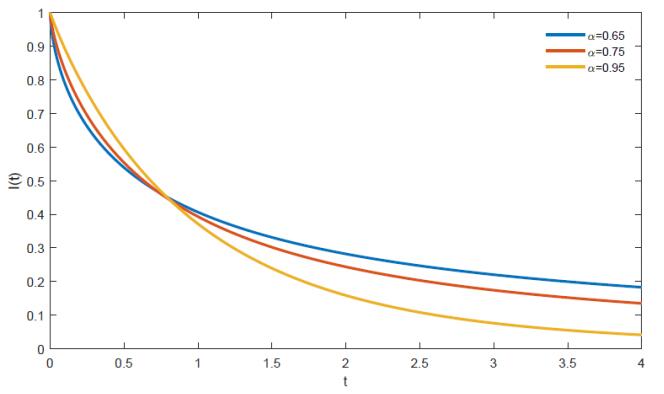









 DownLoad:
DownLoad:
